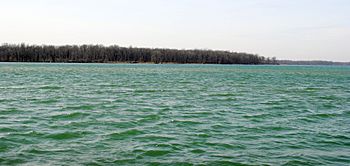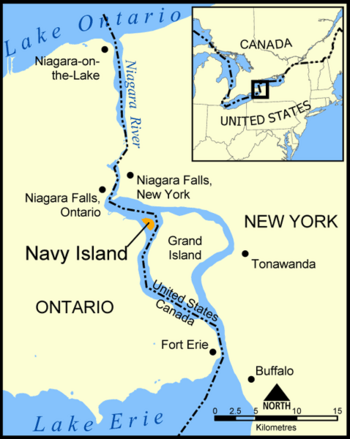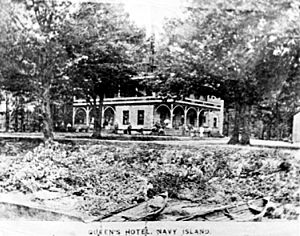Navy Island facts for kids

Navy Island from Buckhorn Island State Park in 2012
|
|
 |
|
| Geography | |
|---|---|
| Location | Niagara River |
| Area | 1.2 km2 (0.46 sq mi) |
| Administration | |
| Province | Ontario |
| Designated: | 1921 |
Navy Island is a small island in the Niagara River. It is located in Ontario, Canada. Parks Canada looks after the island. It is a National Historic Site of Canada.
The island is about 4.5 kilometers (2.8 miles) upstream from Horseshoe Falls. It covers an area of about 1.2 square kilometers (0.46 square miles). Navy Island became a national historic site in 1921. This was because of its important role in building ships. It was also the home of the very short-lived Republic of Canada. Today, the island is closed to visitors. There are no places for people to stay or camp.
Contents
Early Settlers on the Island
People have lived on Navy Island for a very long time. The Lamoka people settled here around 2000 BC. Later, the Meadowood culture peoples lived on the island around 1000 BC.
French and British Control
During the time when France controlled New France, Navy Island was called Île de la Marina. The French built four ships here. They used these ships to travel on the Great Lakes. In 1759, the French burned two of these ships. This happened on nearby Grand Island.
In 1763, France gave New France to the British. The British then set up the Navy Island Royal Naval Shipyard on the island. During the War of 1812, some soldiers were stationed here. They built a small fort and a storage building. The shipyard stopped working around 1813. The island became part of Canada (Upper Canada) in 1822.
The Republic of Canada
In 1837, a man named William Lyon Mackenzie and about 200 of his supporters took over the island. They declared the island the Republic of Canada. The old fort was used by these rebel forces. Mackenzie started with only 25 men. But soon, over 600 men joined him. On January 11, 1838, the rebels were forced to leave the island. They went across the river into the United States.
Island Life and Changes
In 1875, a popular summer resort called the Queens Hotel opened on the island. It was a favorite spot for many people. Sadly, the hotel was destroyed by a fire in 1910.
In the past, there were farms and orchards on different parts of the island. These areas are now empty. Most of the old farmland has grown back into forests. The island has many oak and hickory trees. You can still see some signs that people once lived there. There is a pier that boats used to use. However, the island is now closed to the public. Only Parks Canada staff can use the pier. Camping used to be allowed with special permission, but it is now against the rules. A special plaque about the island is on the south shore of the Niagara River.
A Dream for World Peace
After World War II, Navy Island was suggested as a possible location for the new World Peace Capital. This would also be the headquarters for the United Nations. This idea came from an international committee in 1945 and 1946. People thought the island was perfect because it was between two peaceful countries. An artist even drew pictures of what the World Peace Capital would look like. It showed bridges connecting the island to both the US and Canadian mainlands.
The plan was for Navy Island to be given to the United Nations. It would stay theirs as long as their headquarters were there. If the U.N. moved, the island would go back to the Canadian government. However, this idea was not chosen. The U.N. headquarters ended up being built in New York City.



